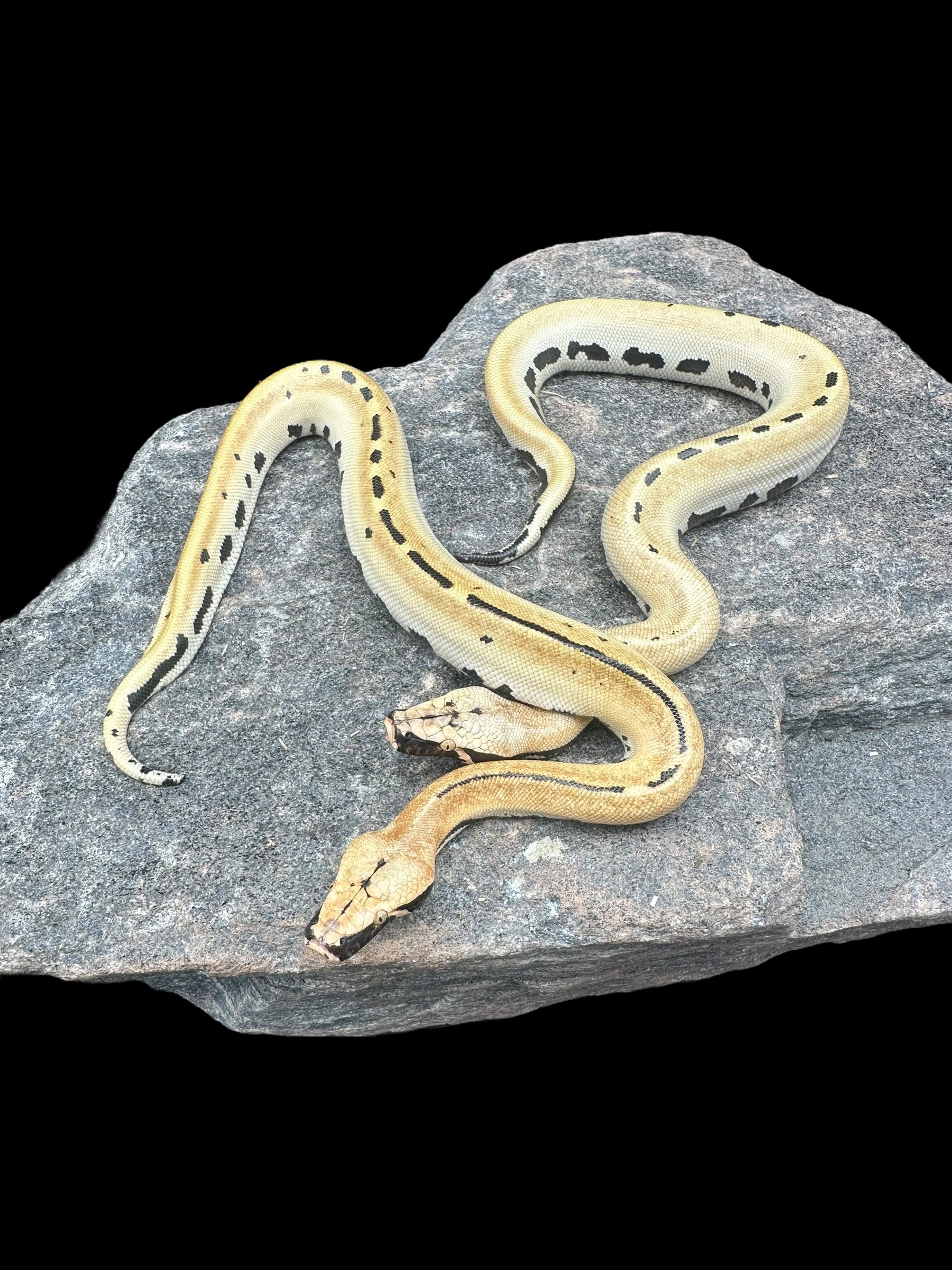Photo Disclaimer
Description
Blood Python (007 Poss Het T+/T- Albino)
Python brongersmai
Common Names: Blood Python, Brongersmai Python
(“007” = Golden Eye + Matrix combo; T+ = Tyrosinase-Positive Albino, recessive morph; T- = Tyrosinase-Negative Albino, recessive morph; “Poss Het” indicates this animal may carry one copy of either or both albino traits)
Species Overview
-
Size: Adults typically reach 4–6 feet (1.2–1.8 m), with females being larger and more robust. Some exceptionally large individuals may surpass 7 feet.
-
Appearance:
-
007 (Golden Eye + Matrix visual combo):
-
Golden Eye: A dominant gene producing golden flecking, brighter tones, and a “metallic” sheen.
-
Matrix: A co-dominant gene that reduces and fragments patterning, creating broken blotches and lateral flames.
-
Together, they form the distinctive 007 look, marked by golden tones and disrupted, cleaner patterning compared to normal Blood Pythons.
-
-
T+/T- Albino (recessive – possible hets): This animal may carry one copy of the T+ gene (caramel to golden tones with reduced black) and/or the T- gene (high-contrast whites, yellows, and oranges with no melanin expression). As a “possible het,” it is not visually expressed and requires test breeding to prove.
-
-
Distribution: Native to Peninsular Malaysia, Sumatra, and nearby islands.
-
Habitat: Found in humid forests, swamps, and agricultural lowlands, where they prefer environments with high moisture and dense ground cover.
-
Behaviour: A heavily bodied, terrestrial ambush predator, feeding primarily on small mammals and birds.
Captive Care
-
Enclosure: Adults require an enclosure of 4 ft × 2 ft × 1.5–2 ft, prioritizing floor space over height. Provide a deep, humidity-retaining substrate, a snug hide, and a large water basin for soaking.
-
Temperature & Humidity: Maintain a basking area at 86–88°F (30–31°C) with a cooler end at 78–80°F (25–27°C). Ambient humidity should remain 60–70%, with spikes to 80% during shedding.
-
Diet: Juveniles can be fed hopper rats or equivalent prey every 5–7 days, while adults typically thrive on medium to large rats every 10–14 days. Take care to avoid overfeeding, as Blood Pythons are prone to obesity.
-
Behaviour in Captivity: Captive-bred 007s are hardy and generally more manageable than wild-caught counterparts. They can be food-motivated and defensive if startled, but most acclimate well with consistent husbandry.
-
Special Considerations: They thrive in naturalistic enclosures with high humidity and deep substrate, which supports burrowing behaviour and hydration.
Genetics Note
-
Golden Eye (Dominant – Visual): Produces golden speckling and enhanced colour.
-
Matrix (Co-Dominant – Visual): Creates reduced, broken patterns with flames and irregular blotches.
-
007 (Golden Eye + Matrix Combo): The combination results in a distinctive golden, disrupted pattern phenotype.
-
Albino (T+ and T- Recessives – Possible Het):
-
T+: Reduces melanin, producing caramel, golden, and chocolate tones.
-
T-: Removes melanin entirely, producing bright yellows, whites, and oranges.
-
As a “possible het,” this animal may carry one copy of either T+, T-, or both, but this cannot be confirmed without breeding trials.
-
The Blood Python (007 Poss Het T+/T- Albino) is both a visually striking morph in its own right and a genetically valuable project animal, with the potential to produce T+ Albino 007s, T- Albino 007s, or even dual-line albino offspring if its het status proves true.

